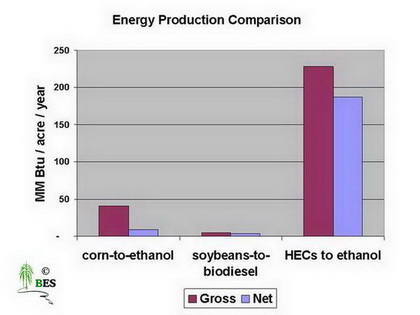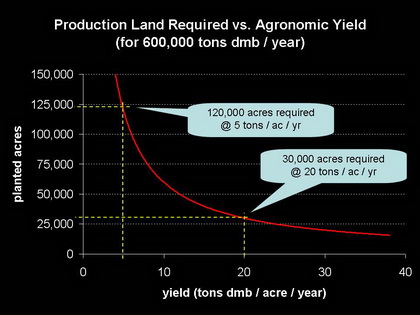BioEnergy Systems LLC (BES) is actively involved in establishing large-scale production of dedicated energy crops in the U.S. and worldwide.
Key considerations regarding dedicated energy crops include:
|
|
|
|
|
This graphic shows that, as expected, the crop with 1/4th the agronomic yield of the high-yield crop would require 4x production land area.
Thus, agronomic yield is critical to minimizing the ecological footprint of an energy crop. |
 |
This graphic shows that the energy production of herbaceous energy crops ("HECs") is expected to be substantially greater than the energy production (gross or net) from first-generation biofuels.
Note the difference between gross energy production and net energy production for each of the biofuels options. |
 |
Energy Crops
|
BioEnergy Systems LLC (BES) is a consulting firm and project development company based in Fayetteville, Arkansas.
BES was established in 2005 by Jim Wimberly. |
click here to learn more about BES |
|
BES works closely with Winrock on a variety of projects and activities related to clean energy, agricultural and rural economic development, and ecosystems management. Winrock International is a nonprofit organization that works with people in the United States and around the world to empower the disadvantaged, increase economic opportunity, and sustain natural resources. |
BES is a supporter of Environmental and Energy Study Institute (EESI), a nonprofit organization established in 1984 by a bipartisan, bicameral group of members of Congress to provide timely information and develop innovative policy solutions that set us on a cleaner, more secure and sustainable energy path. EESI accomplishes these objectives in three ways:
|
BES is a supporter of 25x’25, which is a rallying cry for renewable energy and a goal for America – to get 25 percent of our energy from renewable resources like wind, solar, and biofuels by the year 2025. 25x'25 is supported financially by the Energy Future Coalition, a non-partisan public policy initiative funded by foundations. |
|
BioEnergy Systems LLC 1726 N Charlee Ave Fayetteville, AR 72703 tel: 479-527-0478 fax: 612-605-5749 |
email: info@biomass2.com
website: www.biomass2.com |

